This article explores key factors, and why they’re important, that HVAC engineers consider when designing or calculating air conditioning needs.
- Heat
- Temperature
- Types of Heat
- Modes of heat transfer
- What is air-conditioning
- Comfort conditions
- Ton of refrigeration
- British Thermal unit(BTU)
- Psychrometry
- Psychrometric Chart
- Psychrometric process
- Types of Heat load
- Sensible Heat Factor
- Apparatus dew point
- Bypass factor
- U-Factor
- Co-efficient of performance(COP)
- Air Flow (CFM) & ACPH
1.Heat
The whole airconditioning system calculations are based on addition or removal of heat to or from the space. Heat is the total amount of energy possesses by the molecules in a piece of matter. This energy is sum of both kinetic energy & potential energy of the molecules.
Heat is a form of energy which transfers from Higher temperature body to lower temperature body by virtue of temperature difference between two bodies.

2. Temperature
- Temperature indicates the average kinetic energy of the molecules of substance.
- Temperature is a measure of intensity of heat in substance & determines ability of one substance to transfer heat voluntarily to another substance at lower temperature.

The temperature is a property of a system or thermal state of a body which distinguishes a hot body with cold body.
3.Types of Heat
1.Sensible Heat: The heat added or removed without change in moisture content of air is termed as Sensible heat.
2. Latent Heat: The heat added or removed with change in moisture content of air is termed as Latent heat.
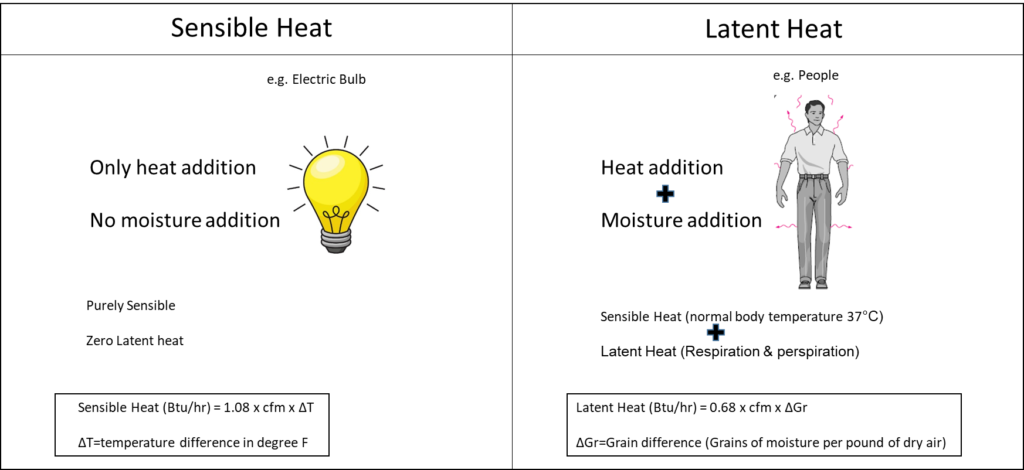
4. Modes of Heat Transfer
Heat is transferred from one space to other by means of any of the below possible mode.

1.Conduction:
- Conduction is a process in which heat is transferred from the hotter part to the colder part in a body without any actual movement of the molecules of the body. Heat transfer takes place from one molecule to another molecule as a result of the vibratory motion (or chain collision) of the molecules.
- Heat transfer through the process of conduction occurs in substances which are in direct contact with each other.
- It generally takes place in solids.
eg. Touching a hot cup of tea, Heat flow from one end to other end of metal rod.
2. Convection:
- Convection heat transfer occurs partly due to the actual movement of molecules from one place to other or due to the mass transfer.
- Heat is transferred in liquid & gases from high temp region to lower temp region.
eg. cold breeze of air passing over body makes you feel colder, Heat flow from boiler shell to water.
3. Radiation:
- Radiation transfers heat by passing from a source to an absorbent surface without heating space in between.
- Radiation heat transfer takes place through vacuum & does not depend on the medium.
- Radiation is the energy emitted by matter in the form of electromagnetic waves
eg. the energy of the sun reaches the earth, Feeling hot when standing close to fire, microwave heating
5.What is Air-conditioning
Air conditioning is the simultaneous control of the following parameters to maintain comfortable conditions.
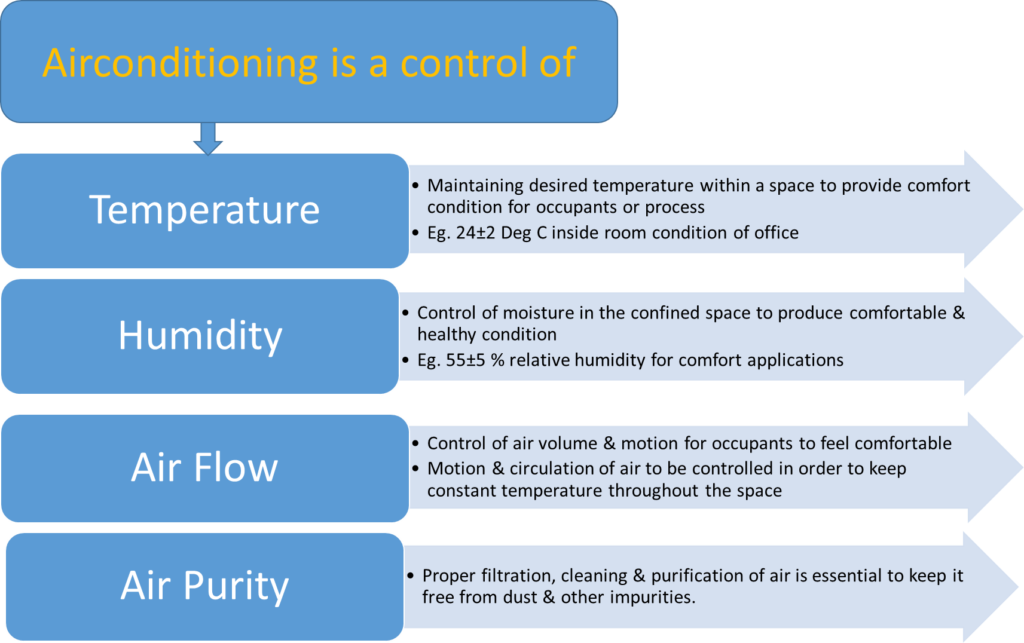
6. Comfort Conditions
Comfort conditions are the condition of desired space or region which shall be maintained above or below outside condition in order to produce comfortable & healthy environment throughout the space. It varies with the type of applications.
This conditions are usually defined by international or national Air-conditioning research institutes like ASHRAE or ISHRAE etc. Few such examples of comfort condition are mentioned below:
Temperature & Humidity
| Application | Temperature (°C) | Humidity (%RH) |
| Ordinary comfort | 24±1 | 55±5 |
| Server Room | 20±1 | <55 |
| Restaurants | 23±1 | 55 |
Air Flow
Air movement or velocity also depends on the application
Generally it is around 10~15 FPM
Air Purity & Noise level
Air purity & noise level depends on the type of application, Ideally we considered 40db for indoors.
Human Comfort Zone is illustrated on psychrometric chart below:
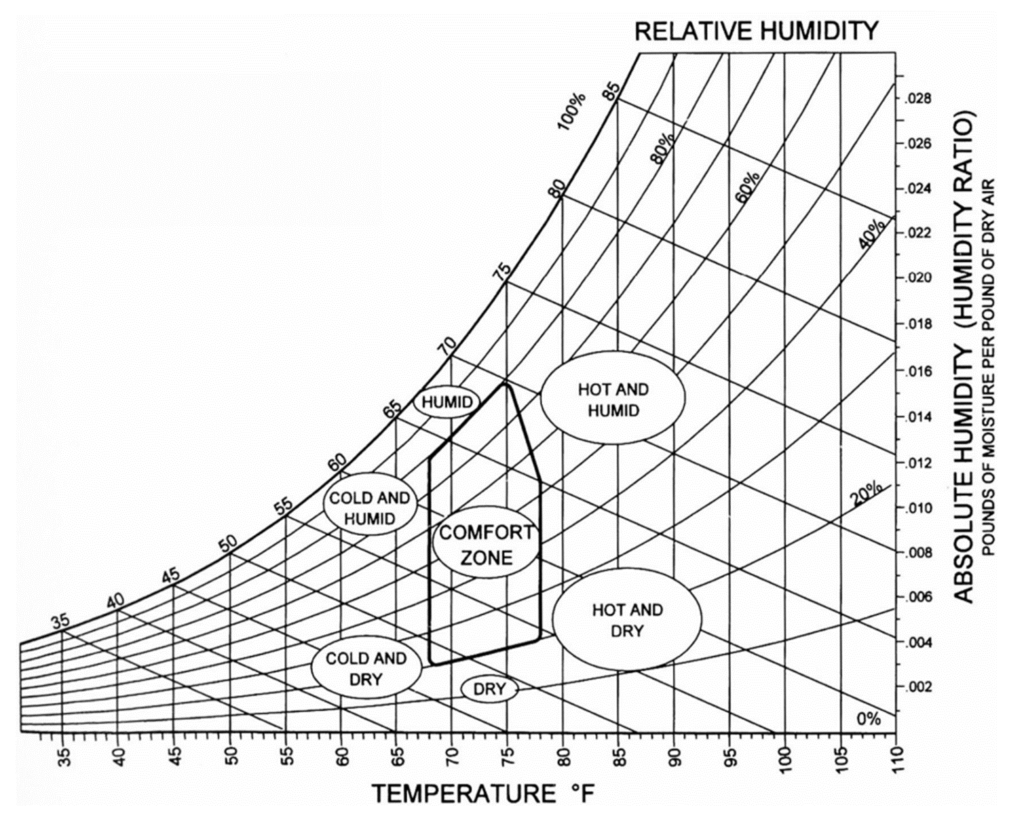
7. Ton of Refrigeration
- One ton of refrigeration is defined as the quantity of heat added to melt one ton of ice at 32 degree F (0 deg C) into water at the same temperature in 24 hours or Vice versa.
- In other words, A ton of refrigeration is a rate of heat transfer, not an amount of heat. One ton is equal to the heat absorbed in melting 2,000 pounds (1 ton) of ice at 32°F in 24 hours (1 day). This equates to 12,000 Btu/hr or 12,000 Btuh.
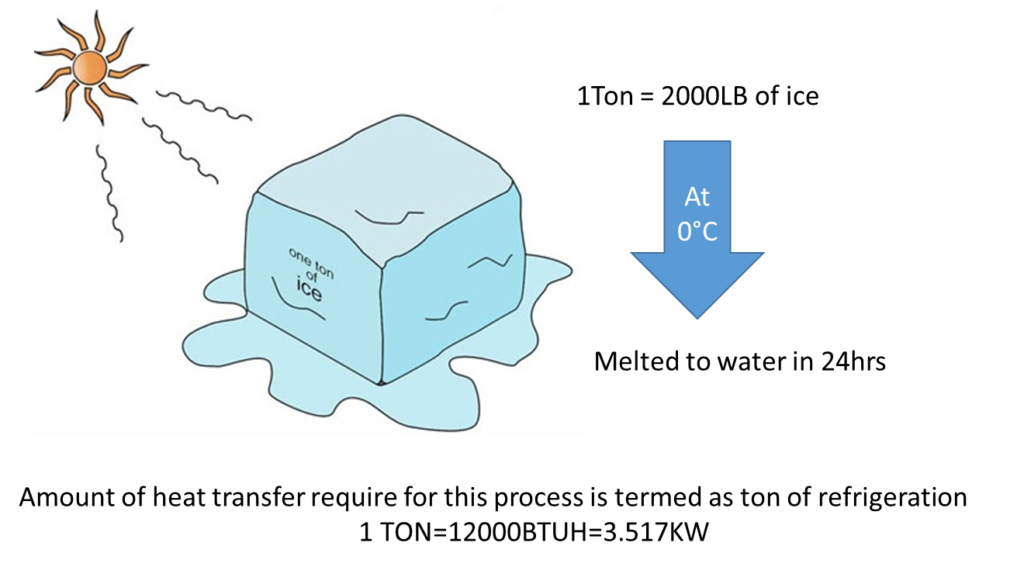
8. British Thermal Unit (BTU)
- One British Thermal unit is defined as the amount of heat to be added (or removed) in order to raise (or lower) the temperature of one pound of water by one degree Fahrenheit (F)

9. Psychrometry
Psychrometry is the branch of science involving study of thermodynamic properties of moist air & the effect of atmospheric moisture on materials & human comfort.
Moist air=Dry air +water vapour (humidity)
Some important psychrometric terms are discussed below:
a) Dry bulb temperature (DBT)
- It is the temperature of air recorded by ordinary thermometer, when it is not affected by moisture present in the air.
b) Wet bulb temperature (WBT)
- It is the temperature of air recorded by ordinary thermometer when its bulb is covered by wetted cloth & exposed to a current of rapidly moving air.
c) Humidity Ratio/Specific Humidity
- It is the mass of water vapour present in 1pound of dry air.
- It is generally expressed in terms of grains per pound of dry air.
1kg=7000grains of moisture
d) Absolute Humidity
- It is the mass of water vapour present in 1 m3 of dry air.
- It is generally expressed in grain per cubic meter of dry air.
e) Relative humidity (RH)
- It is the ratio of actual mass of water vapour in a given volume of moist air to the mass of water vapour needed to saturate it at that temperature & pressure.
- It is generally expressed in percentage.

f) Saturated air
- It is the mixture of dry air & water vapour, when the air has diffused the maximum amount of water vapour into it.
- When the saturated air is cooled the water vapour in the air starts condensing & the same may be visible in the form of moist, fog or condensate.
g) Dew point temperature
- It is the temperature of air measured by thermometer , when the moisture or water vapour present in the air begins to condense
For a saturated air, the dry bulb temperature, wet bulb temperature & dew point temperature is same.
h) Degree of Saturation
- It is the ratio of actual mass of water vapour in a unit mass of dry air to the mass of water vapour in the same mass of dry air when it is saturated at the same temperature.
10. Psychrometric Chart

Important lines in psychrometric chart
- Dry bulb temperature lines: vertical line (shown in red) uniformly placed at 5 deg C interval measured along horizontal axis
- Specific Humidity Lines: or moisture content lines are uniformly spaced horizontal lines (shown in Dark Blue) at 1g interval measured along vertical axis. Measured in g/kg of dry air.
- Dew Point temperature lines: this are also horizontal lines non uniformly spaced measured at saturation curve. At any point on saturation curve dry bulb & dew point temperature are equal.
- Wet Bulb temperature lines: inclined straight lines & non uniformly spaced(shown in light blue) measured along saturation curve. At any point on the saturation curve dry bulb & wet bulb temperature are equal.
- Enthalpy lines: or total heat lines are Inclined straight lines & uniformly spaced parallel to wet bulb temp lines (shown as dotted black) & are drawn upto the saturation curve.The value of Enthalpy are measured on the scale given above the saturation curve.
- Specific volume Lines: these are obliquely inclined straight lines uniformly spaced(shown in orange). The values are shown at the base of chart.
- Relative humidity lines: These are curved lines which follows the saturation curve (shown in green).These lines are drawn with values in percentage such as 10%, 20%,30% etc upto 100%. Saturation curve represents 100% relative humidity line.
11. Psychrometric Processes
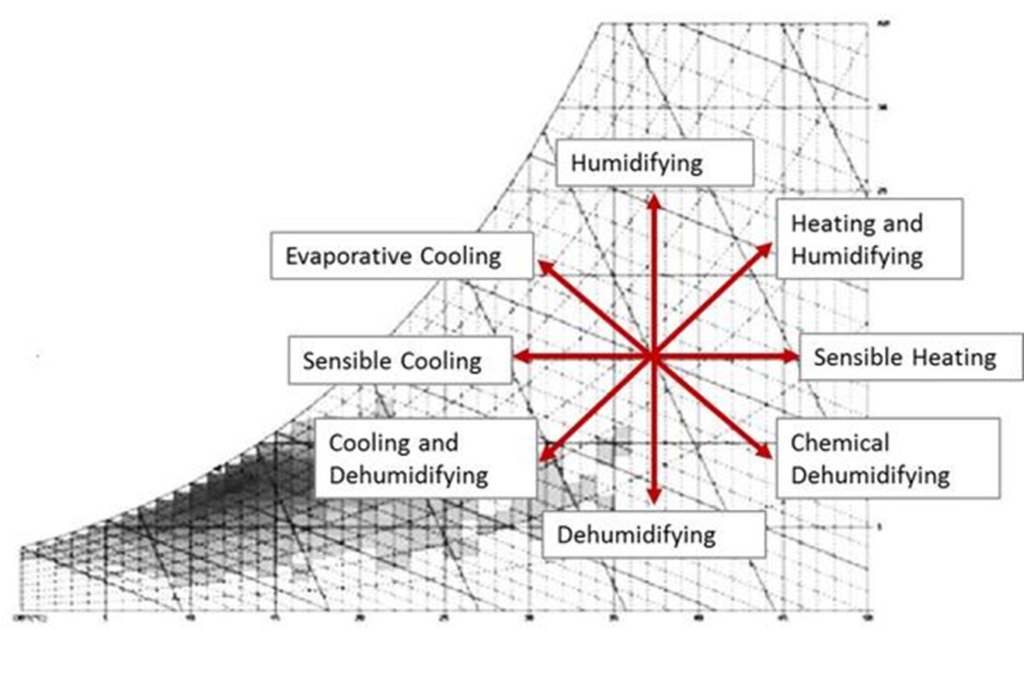
Few important psychrometric process are,
- Sensible Cooling: A process in which dry bulb temperature decreases (removal of sensible heat) without addition or removal of humidity or latent heat.
- Sensible Heating: A process in which dry bulb temperature increases (addition of sensible heat) without addition or removal of humidity or latent heat.
- Cooling & Dehumidification: The process in which the air is cooled sensibly and at the same time the moisture is removed from it. When the air is cooled below its dew point temperature, there is cooling as well as dehumidification of air.
- Cooling & Humidification(evaporative cooling): In this process the moisture is added to the air by passing it over the stream or spray of water which is at temperature lower than the dry bulb temperature of the air.
- Heating & Humidification: the dry bulb temperature as well as the humidity of the air increases. The heating and humidification process is carried out by passing the air over spray of water, which is maintained at temperature higher than the dry bulb temperature of air or by mixing air and the steam.
- Chemical Dehumidification: In this process, the air is passed once through a chemical contact the moisture gets condensed out of the air, and due to the exothermic reaction heat is released which increases the dry-bulb temperature.
12. Types of Heat Load

You can read article on components of heat load, here we will discuss some major components in short.
- External load: the external factors contributes towards adding heat are as follows;
- Solar & radiation heat gain through walls & roof due to temperature difference.
- Radiation heat gain through glass windows.
- Heat added from adjacent non air-conditioned areas due to temperature difference through walls, floors, ceilings or partition.
2. Internal load: the internal factors contributes towards adding heat are as follows;
- Heat gain from people
- Heat gain from lights
- Heat gain from appliances, electric motors etc.
3. Infiltration & ventilation:
- Heat carried along by outside fresh air
- Opening & closing of door brings outside hot air into the room by infiltration.
- Infiltration of outside air from cracks or gaps in walls , doors etc.
- Heat load added due to mechanical ventilation, exhaust fans etc.
13. Sensible Heat factor
- The thermal properties of air can be separated in to latent & sensible heat.
- The term sensible heat factor is the ratio of the sensible heat to total heat, where the total heat is the sum of sensible & latent heat
- SHF along with Room sensible heat factor & grand sensible heat factor is used in plotting supply air conditions to the room.

Click here to read article on Room sensible Heat Factor & Grand sensible Heat factor.
14. Apparatus Dew point (ADP)
Apparatus dew point is the effective coil surface temperature when there is dehumidification. This is the temperature to which all the supply air would be cooled if 100% of the supply air contacted the coil.
Click here to read more about ADP.
15. Bypass Factor

- It represents the portion of the air which is considered to pass through the conditioning apparatus completely unaltered.
- When the by-pass factor is zero, the supply air temperature is equal to coil ADP.
Click here to read post on significance of bypass factor.
16. U factor (thermal transmittance)
- Thermal transmittance, also known as U-value, is the rate of transfer of heat through a structure (which can be a single material or a composite), divided by the difference in temperature across that structure.
- More U more heat transfer. The reciprocal of U is R (resistance) so more R less heat transfer. The better-insulated a structure is, the lower the U-value will be.
- The units of measurement are W/m²K or Btuh/ft2°F
- There are certain U values for certain material which you will find in ASHRAE fundamentals as property of materials.
17. COP (Co-effecient of performance)
- COP of any air-conditioning system is a measure of performance of that system.
- It is derived as the ratio of cooling or heating energy output to the total work (energy) input.
- Greater the COP, higher the efficiency of machine.

18. Air Flow Rate (CFM) & ACPH
- CFM is an acronym for Cubic Feet per Minute.
- CFM measures the volume of air, in cubic feet, for each minute it moves.
- In the case of an air-conditioner, CFM indicates how much air can move per minute. For example, a fan coil units output rated for 30 CFM means 30 cubic feet of air is flowing per minute.
- CFM can be calculated using ACPH or ACH(Air changes per hour) for any given area.

- Value of ACPH are different for different application & can be determined from ASHARE ventilation standards or any national building codes & standards.